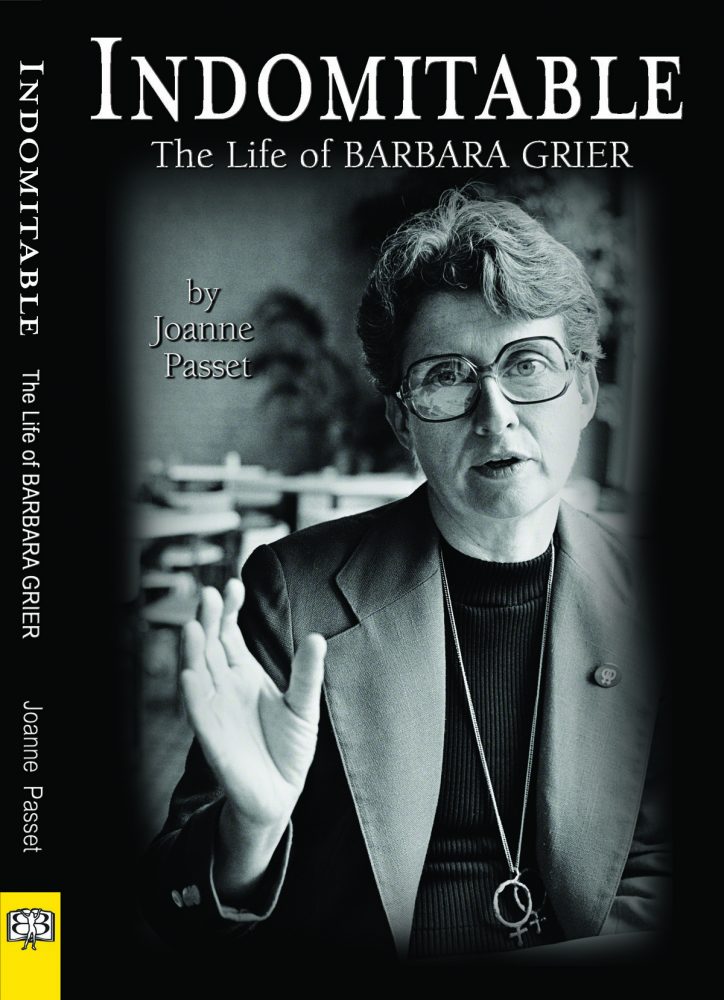Remembering the original lesbian publishing mogul.
Barbara Grier, lesbian publisher, activist and archivist, died Nov. 10 from heart disease. She was 79.
I first met Barbara Grier when I was 19. A fearless young lesbian, not much scared me, but Barbara Grier had a presence that was overwhelming. She had a soft, mellifluous voice, but her words packed a punch and she was fond of saying, “I don’t suffer fools gladly.”
To the tough Midwestern, Kansas-bred mind of Grier, there were an intolerable number of fools in the world and she often took it upon herself to take them on. Her mother had raised her to be independent and independent she was–barely out of her teens before she was propositioning the local librarian, with whom she had a years-long relationship before meeting the woman she called simply, “the love of my life,” Donna McBride, who survives her.
Grier was an irascible character, a throwback to the early days of publishing–she always had a point of view, she always believed she was right and she was always, always passionate. I once called her the Maxwell Perkins of lesbian literature and I don’t think I was wrong in that assessment. Without her vision and drive, lesbian literature might not be what it is today–vibrant, out of the closet, diverse and most important, accessible.
A librarian by trade and an iconoclast by avocation, Grier combined those two passions early. Add in her life-long love of women, and one of the most important figures in lesbian literary history was born. Most lesbians know Grier as the co-founder and longtime publisher of Naiad Books, but she had been invested in lesbian publishing long before the 1973 founding of Naiad.
As one of the editors of The Ladder, which had been founded by Del Martin and Phyllis Lyon as a publication for the Daughters of Bilitis, which they also founded, Grier had a phenomenal impact. The Ladder was the first real lesbian magazine in the U.S., published monthly between 1956 and 1970.
Grier was a contributor throughout the entire run of the publication, writing under the pseudonyms Gene Damon, Vern Niven and Lennox Strong. In 1968 she took over from activist Barbara Gittings as editor of the mimeographed, brown-paper- wrapped magazine and immediately sought to expand both its readership and its content.
Within a month of Grier’s assumption to editor, The Ladder went from between 24 pages to 48–an exceptionally long publication for the time. She also broadened the content to include more news and a much more feminist slant.
In 1973, after The Ladder folded, Grier, long interested in lesbian writers and writing, co-founded Naiad Books, later Naiad Press, which at the time of its closing in 2003, was the world’s largest lesbian publisher. Naiad published romance and mystery novels, predominately.
Some of the best-known lesbian writers of the past 25 years were first published by Naiad–Katherine Forrest, whose Curious Wine is still considered among the most ground-breaking of the “new” lesbian fiction. Grier also published the young Sarah Schulman. The list of award-winning and prolific romance and mystery novelists–Barbara Wilson, Lee Lych, Isabelle Miller, Valerie Taylor, Karin Kallmaker and a host of others put accessible lesbian fiction on the literary map and forced other publishers in the 1980s and on to consider lesbian writers integral to the literary landscape.
The late photographer and artist Tee Corinne created many of the press’s early book covers.
But Grier’s life-long passion as an archivist of lesbian writing led her to revive many out-of-print works of lesbian poetry, memoir and fiction. Among these were important lost pulp novels of the 1940s, 50s and 60s by such writers as Ann Bannon, Jane Rule and Gale Wilhelm. She reprinted the work of Renee Viviene, one of Natalie Barney’s lovers and a member of the 1920s Parisian lesbian set that included Barney, artist Romaine Brooks and writer and model Ida Rubenstein. Grier also published Gertrude Stein’s long, languid prose poem, “Lifting Belly.”
In the 1990s, Grier became the first LGBT publisher to issue audio tape recordings of notable lesbian works, like Curious Wine. In 1985, Grier branched out into the mainstream with the publication of Lesbian Nuns: Breaking Silence. Grier told me she paid a half million to the author/editors, Rosemary Kurb and Nancy Manahan, both ex-nuns.
The book created national controversy, was actually banned in Boston and Grier came under fire for allowing excerpts to be printed in Penthouse magazine. But it was a ground-breaking work that put Naiad firmly on the literary map.
When Grier and McBride retired in 2003, they sold Naiad to Linda Hill at Bella Books. Many of the former Naiad writers, like Kallmaker, continue to publish there.
Grier was perhaps the most important figure of the lesbian literary world in the 20th century. In 1992, she established the Naiad Collection at the James C. Hormel gay and Lesbian Center of the San Francisco Public Library.
In an interview in 2003, Grier told me that it took two vans to take the entirety of books, letters, magazines and other memorabilia such as T-shirts, posters, buttons and the like which she had painstakingly archived over the years from her home in Tallahassee to the library. It is the largest collection of lesbian letters in the world, and includes such important voices as Audre Lorde, Andrea Dworkin, Tee Corinne, Rita Mae Brown among others.
Grier was indeed a force of nature. Not everyone liked her—she could be gruff and had decided at an early age that filtering her words was an unnecessary waste of time. But she had a dry and acerbic wit and she was a vital and impressive woman who worked 20 hour days her entire life and loved every second of it. She was a declarative voice for lesbians over the course of six decades and for those of us who knew her, she was a figure to emulate—for her activism, drive and above all, passion.
